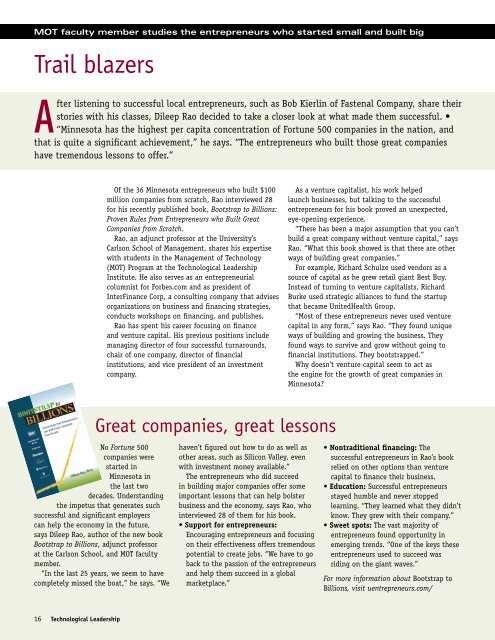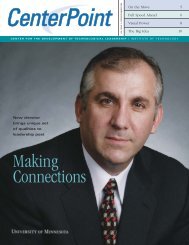MOT faculty member studies the entrepreneurs who started small and built bigTrail blazersAfter listening to successful local entrepreneurs, such as Bob Kierlin <strong>of</strong> Fastenal Company, share their “Minnesota has the highest per capita concentration <strong>of</strong> Fortune 500 companies in the nation, andthat is quite a significant achievement,” he says. “The entrepreneurs who built those great companieshave tremendous lessons to <strong>of</strong>fer.”Of the 36 Minnesota entrepreneurs who built $100million companies from scratch, Rao interviewed 28for his recently published book, Bootstrap to Billions:Proven Rules from Entrepreneurs who Built GreatCompanies from Scratch.Rao, an adjunct pr<strong>of</strong>essor at the <strong>University</strong>’sCarlson School <strong>of</strong> Management, shares his expertisewith students in the Management <strong>of</strong> Technology(MOT) Program at the <strong>Technological</strong> <strong>Leadership</strong><strong>Institute</strong>. He also serves as an entrepreneurialcolumnist for Forbes.com and as president <strong>of</strong>InterFinance Corp, a consulting company that advisesorganizations on business and financing strategies,conducts workshops on financing, and publishes.Rao has spent his career focusing on financeand venture capital. His previous positions includemanaging director <strong>of</strong> four successful turnarounds,chair <strong>of</strong> one company, director <strong>of</strong> financialinstitutions, and vice president <strong>of</strong> an investmentcompany.As a venture capitalist, his work helpedlaunch businesses, but talking to the successfulentrepreneurs for his book proved an unexpected,eye-opening experience.“There has been a major assumption that you can’tbuild a great company without venture capital,” saysRao. “What this book showed is that there are otherways <strong>of</strong> building great companies.”For example, Richard Schulze used vendors as asource <strong>of</strong> capital as he grew retail giant Best Buy.Instead <strong>of</strong> turning to venture capitalists, RichardBurke used strategic alliances to fund the startupthat became UnitedHealth Group.“Most <strong>of</strong> these entrepreneurs never used venturecapital in any form,” says Rao. “They found uniqueways <strong>of</strong> building and growing the business. Theyfound ways to survive and grow without going t<strong>of</strong>inancial institutions. They bootstrapped.”Why doesn’t venture capital seem to act asthe engine for the growth <strong>of</strong> great companies inMinnesota?Great companies, great lessonsNo Fortune 500companies werestarted inMinnesota inthe last twodecades. Understandingthe impetus that generates suchsuccessful and significant employerscan help the economy in the future,says Dileep Rao, author <strong>of</strong> the new bookBootstrap to Billions, adjunct pr<strong>of</strong>essorat the Carlson School, and MOT facultymember.“In the last 25 years, we seem to havecompletely missed the boat,” he says. “Wehaven’t figured out how to do as well asother areas, such as Silicon Valley, evenwith investment money available.”The entrepreneurs who did succeedin building major companies <strong>of</strong>fer someimportant lessons that can help bolsterbusiness and the economy, says Rao, whointerviewed 28 <strong>of</strong> them for his book. Encouraging entrepreneurs and focusingon their effectiveness <strong>of</strong>fers tremendouspotential to create jobs. “We have to goback to the passion <strong>of</strong> the entrepreneursand help them succeed in a globalmarketplace.” Thesuccessful entrepreneurs in Rao’s bookrelied on other options than venturecapital to finance their business. Successful entrepreneursstayed humble and never stoppedlearning. “They learned what they didn’tknow. They grew with their company.” The vast majority <strong>of</strong>entrepreneurs found opportunity inemerging trends. “One <strong>of</strong> the keys theseentrepreneurs used to succeed wasriding on the giant waves.”For more information about Bootstrap toBillions, visit uentrepreneurs.com/16 <strong>Technological</strong> <strong>Leadership</strong>
“That is the $64 billion question, and thereare many reasons,” says Rao. “One reason is thatventure capitalists do well when they are able toinvest in potential home runs in a high-potentialemerging industry. Minnesota has not had anypotential home runs in high-potential emergingindustries for a while.“Another reason is that when venture capitalistsinvest in a company, they expect very high returns.They <strong>of</strong>ten want to put pr<strong>of</strong>essional managers inplace, and there is pressure for rapid growth for rapidreturns. Often this does not work.”By contrast, the successful companies that did notuse venture capital grew at a less forced pace—onethat better matched the nuances <strong>of</strong> the marketplaceand the capabilities <strong>of</strong> the company.His interviews with entrepreneurs such as Schulze,Burke, Kierlin, Glen Taylor <strong>of</strong> Taylor Corporation andthe Minnesota Timberwolves, Horst Rechelbacher,founder <strong>of</strong> Aveda Corp., Stephen Shank, founderand chair <strong>of</strong> Capella Education Co., Gary Holmes,president and CEO <strong>of</strong> CSM Corp., and Earl Bakken,founder <strong>of</strong> Medtronic, among others, also reinforcedthe importance <strong>of</strong> supporting the entrepreneur (seeLessons on page 16).“When I worked in finance, I thought that thesun rose and set with finance,” he says. “I think thesun should rise and set with entrepreneurs and thepassion that entrepreneurs possess.”Rao brings those lessons forward in his classes. Hedeveloped the Financial Management for Technology-Based Organizations course for MOT students as acombination <strong>of</strong> corporate finance and entrepreneurialfinance more than seven years ago and continuesto teach it. He provides MOT students with theframework to understand the role that finance playsin business and in new product development. Heenjoys teaching MOT students.“They are intelligent,” he says. “They arededicated. And they are interested to know howfinance affects their pr<strong>of</strong>essional and personal lives.”In his class, MOT students complete a project thatrequires them to apply what they learned to a newproduct development situation.“I encourage them to tackle a real-life issue,”he says. As his experiences with the bookshow, “understanding the options can make thedifference.”MOT <strong>2010</strong> IMTP experienceThe 15th annual International Management <strong>of</strong> TechnologyProject (IMTP <strong>2010</strong>) course was successfully deliveredin Singapore and Vietnam last March. Led by Pr<strong>of</strong>. DennisPolla, Honeywell/William R. Sweatt Chair and MOT director<strong>of</strong> graduate studies, the 30 students in the MOT Class <strong>of</strong> <strong>2010</strong>assessed technology business opportunities in these twonations.This year, the class set out with the objective <strong>of</strong> contrastingtwo very different national technology strategies practicedin Singapore and Vietnam while carrying out six evaluationstudies <strong>of</strong> specific technology business sectors and potentialopportunities for global business collaborations particularlywith their Minnesota sponsoring corporations.A diverse mixture <strong>of</strong> organizations—universities,government agencies, and large and small corporations—hosted the MOT students.In Singapore the U.S. Embassy and American Chamber <strong>of</strong>Commerce provided an overview <strong>of</strong> U.S. corporate presenceand importance with subsequent visits to GlaxoSmithKline,Boeing, Philips Electronics, Goodrich, iWOW, the EconomicDevelopment Board, and four research organization visits withthe Agency for Science Technology and Research. The class alsovisited the National <strong>University</strong> <strong>of</strong> Singapore’s Management <strong>of</strong>Technology Director, Pr<strong>of</strong>essor Chang Chieh Hang and learnedabout technology management principles needed for operationsin Asia.The U.S. Consulate in Ho Chi Minh City provided an overview<strong>of</strong> the economic and commercial environments <strong>of</strong> Vietnam’seconomy. Twenty-four Vietnamese organizations hosted theMinnesota students including Intel, Saigon Hi-Tech Park, HoChi Minh <strong>University</strong> <strong>of</strong> Technology, and the Laboratory forNanotechnology. Government strategy perspectives by the U.S.Office <strong>of</strong> Naval Research—Global and the Vietnam Minister <strong>of</strong>Science and Technology completed the international residency.Pr<strong>of</strong>. Polla commented “This was an intense trip with over 40international organizations interacting and collaborating withMinnesota companies. Both Singapore and Vietnam rolled-outthe red carpet for our students.”The IMTP <strong>2010</strong> experience did not end in Asia. Studentsalso presented a final out-briefing to State <strong>of</strong> Minnesota ChiefInformation Officer, Commissioner Gopal Khanna.<strong>Fall</strong> <strong>2010</strong>/<strong>Winter</strong> 2011 17








